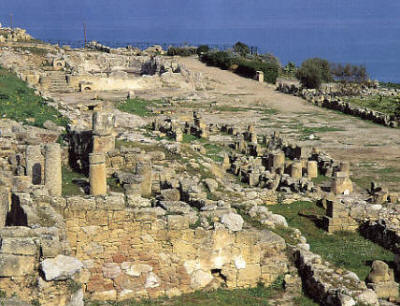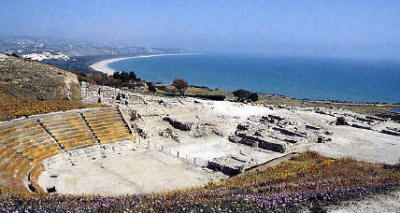
Solunto: photo M. Cuccia
1) SOLUNTO: A Punic city
founded by the middle of the 4lh cent. with a strong Greek
influence. Some great remains of a large square, a theatre, an
odeon and part of the old streets.
2)
ADDAURA: A few caves with Palaeolithic engravings, on
the west slope of Mount Pellegrino, Palermo.
3) MONTE JATO: 30 km. away
from Palermo. Some ruins of a Hellenistic time theatre, the stage
structure, the agora, and a few houses.
4) SEGESTA: 4 km. away from
Calatafimi, its origins date back b the age of Elimi (people
descending from the merge between Sioanians - the first inha
bitants of Sicily - and fugitives from Troy). Because of its
rivalry towards Selinunte, it caused the intervention by Athenians
in ihe year 415 and by Carthaginians in 409. The very well
preserved Doric temple is a peristyle of the second half of the
5th cent. The 3rd century theatre on the top of a hill is still
well preserved, with its tiers divided into seven wedge-shaped
parts and iutting out parascenia.
5) ERICE: An Elimian city
in a wonderful position. Renowned in ancient times for the
sanctuary of the Fertility Goddess (whose name was Aslarte for
Phoenicians, Aphrodite for Greeks and Venus for Romans).
6) MOZIA: A Punic city in a
small island 8 km from Marsala. Some huge ruins of defensive works
all around the island and an interesting "Tophet" area where
children sacrifices took place.
7) MARSALA: Once called
Lilibeo, it was a Sicanian city where exiles from Mozia moved,
followed by the ones from Selinunte. Some important fortifications
defended it from Pyrrhus and the Romans but it was finally
defeated after Egadi Battle in 242. There are many graves left as
well as funeral niches containing Phoenician and Greek
inscriptions, some houses and remains of publics buildings with
large rooms decorated with both geometric and figurative mosaics.
A Punic boat drawn out of Stagnone waters is kept at Baglio
Anselmi.
8) SELINUNTE: It was
founded in 650 by settlers coming from Megara Hyblea, and
destroyed by Carthaginians in 409 and 250. There are some huge
fortifications dating back to 5lh-6lh cent. all around the
acropolis, the Doric "C" temple on the outskirts, three big
temples (E, F and G) some magnificent remains of houses.
9) ERACLEA MINOA: Close to
the mouth of the river Platani, it was a frontier - city between
the influence of Agrigento and Selinunte, then of Siceliols and
Carthaginians. Some defence walls and a 3rd century theatre.

Eraclea Minoa
10) AGRIGENTO: Founded by
people from Gela in 583. A marvellous temples valley bounded on
the northern side by the Rupe Atenea and by the Greek city
acropolis. In the archaeological park you can admire Demetra's
Doric temple, Ctonian Gods' sanctuary, Juno's temple, the temple
of Concord, Hercules's and Olympian Jupiter's temples as well as
the temples of Dioscurj, Esculapio. A rich archaeological museum
is to be held in great consideration.
11) GELA: Founded by
Cretans around 689, it was the main city until Gelone moved the
seat of power to Syracuse in 485. It was destroyed by
Carthaginians in 405, rebuilt by Timoleonte and then destroyed
once and for all by Mamertins at the beginning of the 3rd century.
Some ruins of two temples of Athena's, houses, huge defence works
on the hill of Cape Soprano, and an important archaeological
museum.
12) CENTURIPE: Its origins
date back to the age of Siculi (people who arrived in Sicily from
Southern Italy many years after Sicani). It grew under Greeks and
developed under Romans. During ancienttimes it was renowned for
ceramics and polychrome tempera - painted pottery. A marble
building of Augustales and some remains of public structures.
13) PIAZZA ARMERINA: A
wonderful Roman villa of the 3rd - 4th cent. A.D., including
thermal baths, peristyles, courtyards and arcades, is in "Contrada
Casale". Many marvellous and matchless mosaics cover almost every
room with figures representing mythological and historical
subjects as well as scenes from everyday life. The Villa
Filosofana of Casale is unforgettable.
14) MORGANTINA: A Greek and
Sicul city rebuilt several times and finally destroyed by Romans
in 211 B.C., where it is possible to see some remains of the city
walls, of many public buildings in the Agora, and some private
houses containing mosaics and arcades.
15) CAMARINA: Founded by Syracusians at the end of the
6th cent. Some remains of Athena's temple and of city walls.
Ippodamo - styled urban frame is near to an interesting
necropolis where some rich funeral outfits, now kept in Syracuse
Museum, were discovered.
16) SYRACUSE: First
onginated in the small island of Ortigia, it later extended toward
the mainland with its Acradina, Tyche and Neapolis quarters and
with Eliopoli stronghold. For a very long time it struggled
against Carthaginians, Athenians and Romans by whom it was
conquered in 212. It is very important as far as archaeology is
concerned because of the ruins of the archaic Apollion and Temple,
the Athenian, some military buildings such as Eurialo castle, the
superb and magnificent Greek theatre, the majestic altar of Gelone
ll, and the Roman amphitheatre.
17) PALAZZOLO ACREIDE: A
Syracuse settlements in 664. Some huge remains of the urban frame,
the lower part of a Doric temple, a 3rd century theatre, the
Bouleutherion and Latomie.
18) PANTALICA: In the Anapo
valley, it is thought to be the ancient Ibia, capital of a
natives' reign from eight to seven hundred years B.C. On its
calcareous walls there are 5.000 small cave-shaped graves typical
of the late Bronze Age.
19) MEGARA HYBLEA: An urban
settlement corresponding to today's harbour of Augusta. Under
Syracuse's influence, it was destroyed by the Romans of Marcello
during the 2nd Punic war. A few remains of the agora and city
streets. Some important Doric statues as well as pottery, now kept
in Syracuse Museum, were discovered.
20) CATANIA: it was founded by
Calcidians in 729, then settlers from Syracuse came and renamed it
Aitna. During the time of Augusta it had its golden age. There is
a very important roman theatre with a horseshoe shaped auditorium
divided into nine wedges and marble orchestra and stage. A half -
circled Odeon and its outdoor portico are close to the theatre.
21) NAXOS: First Greek
settlement in Sicily, it was founded by Calcidians in 736. It took
part in every war against Syracuse and formed an alliance with
Athens until it was destroyed by Dioniso of Syracuse in 413. Some
remains of the city walls, Aphrodite's temple and build - up areas.
22) TAORMINA: It was founded
in 358 B.C. and remained under Syracuse's influence until it was
conquered by Romans. The Greek time left a temple close to the
Odeon and Serapeion. The bricks Greek theatre has an upper gallery
and an outdoor arcade as well as a stage outlook with large niches
beyond columns. Some remains of the gymnasium, a two naves pool
and thermae.
23) TINDARI: It was founded in
396 B.C. by Dionisio I of Syracuse. A 4lhcant. B.C. theatre
reodapted for circus games in the imperial age is to be seen, as
well as a basilica very interesting for its barrel - vaults
interposed by arches, a sort of prelude to the great Roman
architecture.
24) IMERA: Neighbouring to
Termini Imerese, it was founded by the Calcidians of Zancle
(Messina) in the latter half of the 7th cent. There are a sacred
zone with three temples and a few remains of build - up areas. The
peripteral Doric temple of Victory is just outside the city
boundary.
25) AEOLIAN ISLANDS: Lipari
and the six nearby islands were inhabited since prehistoric period
and were also an important trade - spreading centre during
Neolithic age until historical time. They were colonized by
Rhodians during the 6th and 5th century. They fought together with
Syracuse against Carthage, and later with Carthage against Rome.
Lipari's Archaeological Museum is one of the most important in
Sicily.